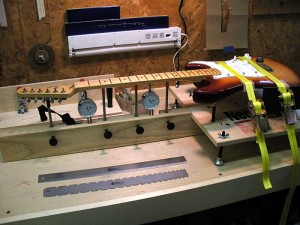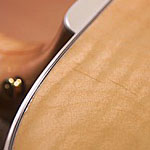 I am including this article as a special page in the Services Menu because of the frequency with which the issue of high tongue frets arises. The tongue is the part of the fretboard that extends into the body of the guitar. On acoustic guitars, the tongue extends past the heel of the neck and usually falls away slightly from level due to the nature of construction and the neck angle. However, most electric guitars are made differently, without a tongue extension that is separate from the heel. When tension is brought to bear on the guitar from the pull of the strings, the tongue on electric guitars has a tendency to kick up slightly resulting in buzzing. This is especially true of guitars with bolt-on necks such as Tele and Strat type guitars. A bolt-on neck also has exposed end grain which is more likely to absorb moisture and swell a tiny bit. Electrics with set necks (such as Les Paul types) are generally less prone to this problem, but I’d estimate that at least 80% of bolt-on necks that come into my shop have a high tongue. This is true of brand-new guitars right off the shelf. I could go into any local Guitar Center and start pulling new Strats off the wall and show you in less than 60 seconds with a good straight edge that most of them have high tongues. In fact, a good customer of mine recently had me perform a setup on a $6000 Custom Shop Strat with an amazing relic finish. You guessed it… three zeros in the price and it still had high frets on the tongue and was buzzing. True story!
I am including this article as a special page in the Services Menu because of the frequency with which the issue of high tongue frets arises. The tongue is the part of the fretboard that extends into the body of the guitar. On acoustic guitars, the tongue extends past the heel of the neck and usually falls away slightly from level due to the nature of construction and the neck angle. However, most electric guitars are made differently, without a tongue extension that is separate from the heel. When tension is brought to bear on the guitar from the pull of the strings, the tongue on electric guitars has a tendency to kick up slightly resulting in buzzing. This is especially true of guitars with bolt-on necks such as Tele and Strat type guitars. A bolt-on neck also has exposed end grain which is more likely to absorb moisture and swell a tiny bit. Electrics with set necks (such as Les Paul types) are generally less prone to this problem, but I’d estimate that at least 80% of bolt-on necks that come into my shop have a high tongue. This is true of brand-new guitars right off the shelf. I could go into any local Guitar Center and start pulling new Strats off the wall and show you in less than 60 seconds with a good straight edge that most of them have high tongues. In fact, a good customer of mine recently had me perform a setup on a $6000 Custom Shop Strat with an amazing relic finish. You guessed it… three zeros in the price and it still had high frets on the tongue and was buzzing. True story!
Why is this? The bottom line is that the bolt-on neck was invented as a means to mass-manufacture guitars as inexpensively as possible. Milling a neck from a flat slab of wood is more cost-effective than making one with an angle on the peghead. Music and musicians have come a long way since the early days of rock and roll and that plunky Beach Boys sound produced by a Telecaster with heavy strings. But the guitars are still being mass produced in nearly the same way, and the high tongue issue is an inherent problem with the manufacture of bolt-on necks.
Could this problem be corrected at the factory? Of course! The real issue is at what cost? The solution would involve milling a slight fall-a-way into the tongue area of the neck/fretboard before installing and leveling the frets. Because this would entail time and labor, such necks could not be made and marketed as cheaply as they currently are, so the factories aren’t going to address the problem. They keep cranking them out and sending them out with excess neck relief and high action to offset the buzzing problem caused by the high tongue. And as long as customers keep buying them without complaining, they’ll continue to do this ad infinitum.
So what’s a player to do? The first thing I’d recommend is to shop for a guitar (new or used) with as little tongue rise as possible. Every neck was once part of a tree and they are all individual, with individual stiffness and build characteristics. Many famous Strat and Tele players have switched necks and gone through many instruments to find the one they love. They also have skilled techs that they pay to keep the guitars set up and playing the way they want. This leads to the next suggestion: Once you settle on a guitar you intend to live with long term, have a skilled luthier evaluate the neck and frets as well as the setup.
The best way to correct a high tongue is for the luthier to do a complete re-fret of the neck, taking some material off of the fretboard in the tongue area before installing and leveling the new frets. Expect to pay at least $350 for this service, even more in the case of a finished Maple fretboard. Obviously this is not cost effective for an inexpensive import or a guitar that you feel you may not keep. But it is the cure for an otherwise great guitar with this issue. A less effective and less expensive technique for dealing with high fret buzz is to have a fret leveling done, paying extra attention to lowering the tops of the tongue frets. Depending on how high they are, it may be necessary to lower the frets to the point that they are rather flat on top and can’t be crowned as nicely as the rest of the neck. But this technique can help a lot, and can make a buzzing guitar play much better.
Some players express frustration with having to pay for fret work on a new guitar. Trust me, I am as frustrated as you! If we need to cast blame, let’s cast it where it belongs- on the cheap mass-production of guitars and the inherent problems associated with inferior workmanship. No one would buy a new car that ran rough because of a bad tune-up… if enough guitar buyers sent back buzzing guitars for warranty repair or replacement, this problem might find a permanent solution!
Check out this vido from my YouTube channel where I discuss and demonstrate this common problem with bolt-on necks.

